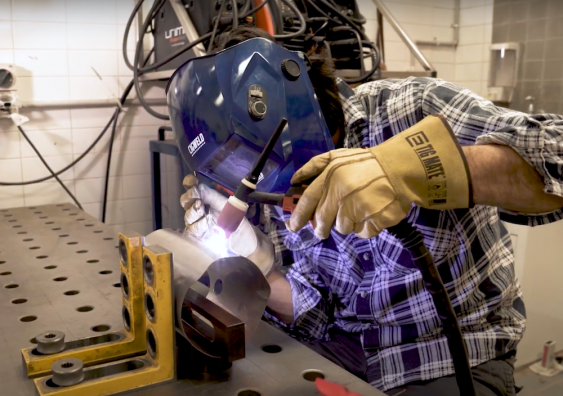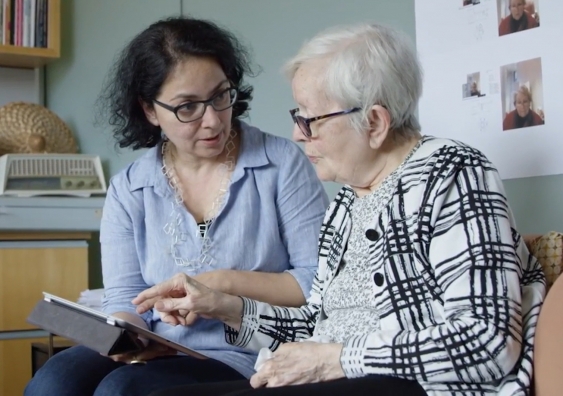An experimental outdoor furniture project aims to better understand how women, girls, and gender-diverse individuals use public spaces.
UNSW Sydney industrial designers, Massachusetts Institute of Technology (MIT) urban technology planners and Transport for NSW have launched a new smart seating project to help enhance the usability and inclusivity of public space. The innovative outdoor benches feature motion-activated LED lighting and are monitored by AI technology to learn more about how people interact with their urban environments.
The Benchmark NSW project, which was funded by Transport for NSW under the Safer Cities program, aims to better understand how people, particularly women, girls and gender-diverse people, use and experience public spaces to inform future urban design and planning decisions.
The benches were officially unveiled last fortnight and will be installed at the UNSW Village Green for the next month. Members of the public can interact with the seating and participate in a survey to provide valuable insights into public space usage for the broader Safer Cities program.
Gonzalo Portas, Chief Investigator and Associate Lecturer in Industrial Design at the School of Built Environment, UNSW Arts, Design & Architecture, says the project demonstrates the power of disciplines helping to create safer and more welcoming public environments.
“Through this project, we hope to create a model for smart, safe, and inclusive public spaces that can be replicated across various urban environments,” says Mr Portas. “By involving diverse voices in the design process and leveraging cutting-edge technology, we aim to address the unique needs and preferences of underrepresented groups in public spaces.”
Media enquiries
For enquiries about this story and interview requests, please contact Ben Knight, News & Content Coordinator, UNSW Arts, Design & Architecture.
Phone: (02) 9065 4915
Email: b.knight@unsw.edu.au
Four women students from the Industrial Design program were also involved in designing and fabricating the smart seating solutions. Ms Rina Bernabei, Adjunct Senior Lecturer in Industrial Design, also worked with the team critiquing and developing the students’ ideas.
“The creative and thoughtful designs of our Industrial Design students were brought to life with the support of our Design Futures Lab at UNSW,” says Dr Mariano Ramirez, Co-Investigator and Discipline Director of Industrial Design. “This hands-on experience enriched their learning and contributed significantly to the project’s success.”
Design of the smart seating
The seating units were fabricated from the Design Futures Lab, with a distinctive and durable design made from 100 per cent Australian recycled plastic sheets. Each one is relatively lightweight allowing them to be used and moved around based on user preference.
“Users can flexibly sit in various positions, including cross-legged on top, perching on the edge, reclining against them, or straddling them like benches,” Mr Portas says. “They are also free to reposition the chairs to other locations within the UNSW Village Green, adding to the interaction and flexibility.”
The smart seating incorporates LED lighting strips, which illuminate when there is movement nearby to increase visibility. The seating area is monitored using AI vision technology developed by MIT’s Norman B. Leventhal Center for Advanced Urbanism (LCAU), which detects general movement and usage patterns. Observations and surveys alongside the technology are used to understand user characteristics like gender, which is incorporated into the analysis.
“We want to know what makes women and girls feel safe in public space,” says Associate Professor Sarah Williams, Director of the MIT Civic Data Design Lab. “So, using the power of AI vision recognition software, we’re able to detect how people interact with our seating and whether they feel comfortable enough to sit and stay for long periods, alone or with others, indicating they feel safe.
“This data, combined with the survey responses, will help validate our findings.”
There is no data-capturing technology mounted in the seats. Instead, a camera mounted on a nearby pole detects the bench shapes and movement of people. Using the latest technology, images from the camera are quickly interpreted and translated into x and y locations and then deleted to ensure personal privacy. Then, the data is turned into insights, such as pedestrian frequency, duration of use of the site, and relative location of visitors within the site, allowing the team to analyse whether the intervention created a safer environment.
“What’s unique about the AI vision recognition software is that it doesn’t collect identifiable data,” A/Prof. Williams says. “The software recognises the bench model and how users interact with it but deletes image frames permanently, leaving behind just dot points on a map that we can analyse.”
Impact for community
Mr Rory Brown, A/Executive Director of Smart Places, Transport for NSW, says the Benchmark NSW project represents a significant step forward in creating safer, more inclusive public spaces, particularly for women, girls, and gender-diverse individuals.
“This project exemplifies the power of collaboration between academia, industry, and government,” Mr Brown says. “It highlights the importance of inclusive design and the potential of smart technology and data to improve public spaces.
“Together, we are making a tangible difference in how public spaces are designed and experienced.”
The project team acknowledge the contribution of student collaborators Ms Eleanor Tang, Ms Grace Wong, Ms Christine Chen, and Ms Eugenia Cheung.









